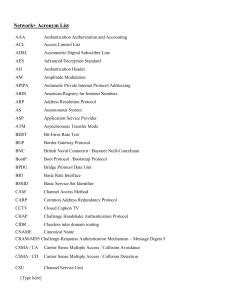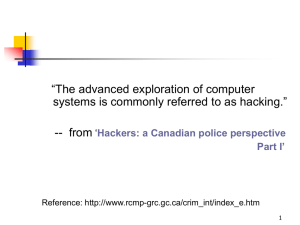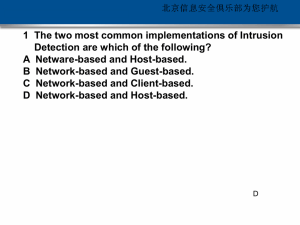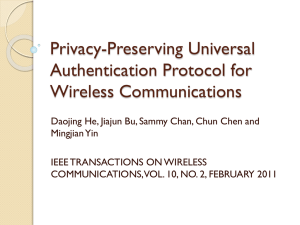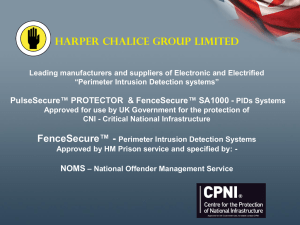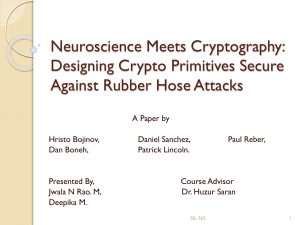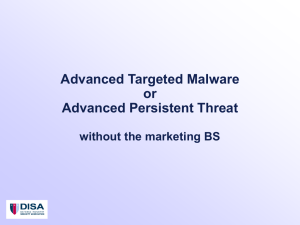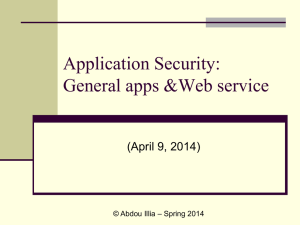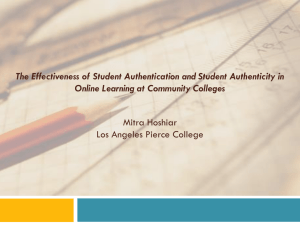Computer Security Techniques
advertisement
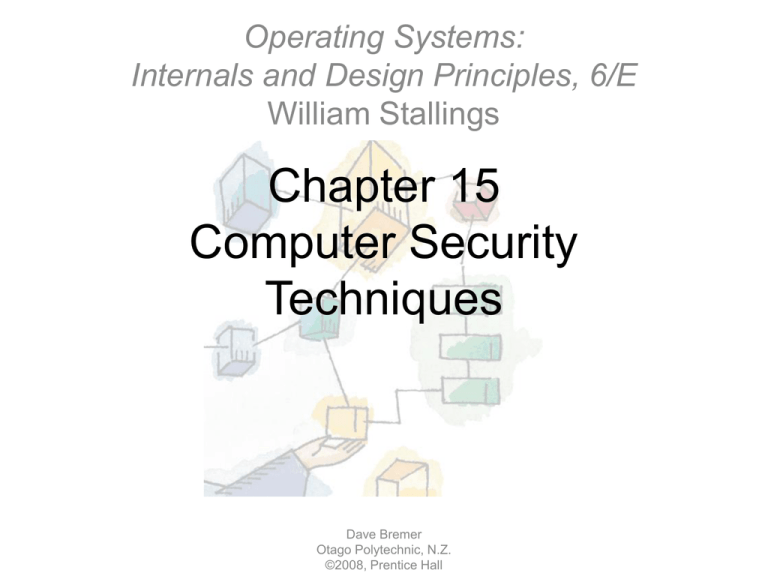
Operating Systems: Internals and Design Principles, 6/E William Stallings Chapter 15 Computer Security Techniques Dave Bremer Otago Polytechnic, N.Z. ©2008, Prentice Hall Roadmap • • • • • • Authentication Access Control Intrusion Detection Malware Defense Dealing With Buffer Overflow Attacks Windows Vista Security Authentication • Basis for most type of access control and accountability • Two steps – Identification – Verification Means of Authentication • Traditionally listed as three factors • Something you know – Password, PIN • Something you have – Card, RFID badge • Something you are – Biometrics A different take • Nick Mathewson is attributed with turning these factors into: – Something you had, – Something you forgot, – Something you were! Biometrics expanded • Recently Biometrics (something you are) has been expanded into: • Something the individual is – Static Biometrics: Fingerprint, face • Something the individual does – Dynamic Biometrics: handwriting, voice recognition, typing rhythm Password-Based Authentication • Determines if user is authorized to access the system • Determines privileges for the user • Discretionary access control may be applied Hashed Passwords • Widely used technique for storing passwords • Secure against a variety of cryptanalytic attacks UNIX Password Scheme Salt • Prevents duplicate passwords from being visible in the password file. • Greatly increases the difficulty of offline dictionary attacks. • It becomes nearly impossible to find out whether a person with an account on multiple systems has used the same password for all. Token-Based Authentication • Objects that a user possesses for the purpose of user authentication are called tokens. • Examples include – Memory cards – Smart cards Memory Cards • Memory cards can store but not process data. • Often used in conjunction with password or ping • Drawbacks include – Requires a special reader – Token loss – User dissatisfaction Smart Cards • Contains microprocessor, along with memory, and I/O ports. • Many types exist differing by three main aspects: – Physical characteristics – Interface • Static • Dynamic password generator • Challenge-response Static Biometric Authentication • Includes – Facial characteristics – Fingerprints – Hand geometry – Retinal pattern • Based on pattern recognition, – technically complex and expensive. Dynamic Biometric Authentication • Patterns may change • Includes – Iris – Signature – Voice – Typing rhythm Cost versus Accuracy Roadmap • • • • • • Authentication Access Control Intrusion Detection Malware Defense Dealing With Buffer Overflow Attacks Windows Vista Security Access Control • Dictates what types of access are permitted, under what circumstances, and by whom. – Discretionary access control – Mandatory access control – Role-based access control Not mutually exclusive Extended Access Control Matrix Organization of the Access Control Function Role Based Access Control • Effective implementation of the principle of least privilege • Each role should contain the minimum set of access rights needed for that role. • A user is assigned to a role that enables him or her to perform what is required for that role. – But only while they are performing that role Roles Access Control Matrix Representation of RBAC Access Control Matrix Representation of RBAC Roadmap • • • • • • Authentication Access Control Intrusion Detection Malware Defense Dealing With Buffer Overflow Attacks Windows Vista Security Some Definitions • Security intrusion: – A security event in which an intruder gains access to a system without authorization. • Intrusion detection: – A security service that monitors and analyzes system events to find intrusions and provide alerts Intrusion Detection Systems (IDS) • Host-based – Monitors a single host • Network-based – Centrally monitors networks traffic, devices IDS Components • Sensors – Collect data and forward to the analyzer. • Analyzers – Determines if an intrusion has occurred • User interface Profiles of Behavior Host-Based IDSs • Can detect both external and internal intrusions • Anomaly detection – Collection of data relating to behavior of legitimated users over time may use • Threshold detection • Profile based detection • Signature detection – Define set of rules or attack patters Audit Records • Native audit records – Uses the OS accounting software/logs • Detection-specific audit records – Generate audit records required by the IDS Roadmap • • • • • • Authentication Access Control Intrusion Detection Malware Defense Dealing With Buffer Overflow Attacks Windows Vista Security Antivirus Approaches • Ideal approach is prevention, don’t allow a virus onto the system! – Impossible in many cases. • Next best approach requires: – Detection – Identification – Removal Generic Decryption (GD) • When a file containing a polymorphic virus is executed, the virus must decrypt itself to activate. • GD Detection requires – CPU emulator – Virus signature scanner – Emulation control module Digital Immune System • A comprehensive approach to virus protection developed by IBM, refined by Symantec. • Aims to provide rapid response times to combat viruses as soon as they are introduced. Digital Immune System Behaviour Blocking Software • Integrates with the operating system – monitors program behavior in real time for malicious actions and blocks them. • Monitored behaviors may include: – opening or modifying certain files – formatting disk drives – Modifications to executable files or macros – Modification of critical system settings – Network communication Behavior-Blocking Software Operation Worm Countermeasures a. Signature-based worm scan filters b. Filter-based worm containment c. Payload-classification-based worm containment d. Threshold random walk (TRW) scan detection e. Rate limiting f. Rate halting Botnet and Rootkit Countermeasures • IDS and Anti-Viral techniques are useful against bots – Main aim is to detect and disable a botnet during its construction • Rootkits are, by design, difficult to detect – Countering rootkits requires a variety of network- and computer-level security tools. Roadmap • • • • • • Authentication Access Control Intrusion Detection Malware Defense Dealing With Buffer Overflow Attacks Windows Vista Security Buffer Overflow • Protection from stack buffer overflows can be broadly classified into two categories: • Compile-time defenses – Aims to harden programs to resist attacks in new programs • Stack protection mechanisms – Aims to detect and abort attacks in existing programs Compile Time Defenses • Choice of Programming Language – Some languages do not allow some unsafe coding practices • Safe Coding Techniques and Auditing • Language Extensions and Use of Safe Libraries • Stack Protection Mechanisms Run Time Defenses • These defenses involve changes to the memory management of the virtual address space of processes. – Executable address space protection – Address space randomization – Guard pages Roadmap • • • • • • Authentication Access Control Intrusion Detection Malware Defense Dealing With Buffer Overflow Attacks Windows Vista Security Windows Vista Security • Access control scheme – Access token – Indicates privileges Access Mask
